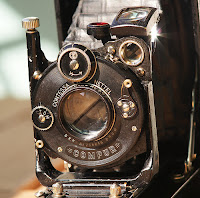 Here is proof that it is not only the processor in your digital camera, but the optics that shoot the image that make a difference in quality. Contessa Nettel Cocarette adapted an old film camera with a Zeiss lens to attach to her digital SLR. Thanks to Make magazine for the find.
Here is proof that it is not only the processor in your digital camera, but the optics that shoot the image that make a difference in quality. Contessa Nettel Cocarette adapted an old film camera with a Zeiss lens to attach to her digital SLR. Thanks to Make magazine for the find.Contessa Nettel Concarette with Carl Zeiss Tessar 105mm f/4.5
This is a 6x9 rollfilm camera made by Contessa Nettel (one of the companies which merged to form Zeiss Ikon in 1926). The lens is a Carl Zeiss Jena Tessar 105mm f/4.5, in a dial-set Compur shutter. The camera has rack focusing, meaning that the entire lens assembly moves for focusing. This gives higher image quality than front-element focusing, where only the front element of the lens is moved.
The camera's back doesn't open, but rather the film is first loaded onto an insert that slides into the camera. The back, however, has a small circular door for cleaning the back of the lens.
I removed the circular door from the back of the camera and glued a short (11mm) M42 extension tube in it's place. Now the entire camera can be attached to my DSLR with an M42 adapter, and pictures can be taken through the lens. Thanks to the rack focusing mechanism, infinity focus is possible by not fully extending the bellows. For close-up photography, the bellows work really well for macro extension.
In my initial test shots, the lens has proven to be very sharp.
Based on the serial number of the lens, this camera was probably made in 1923. Certainly before the Zeiss Ikon -merger in 1926.
Be sure to check out her crop comparison of the same image taken with and without the Zeiss adaptation.









